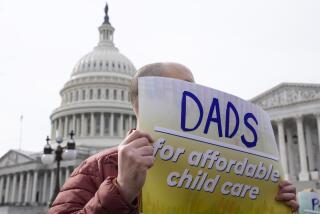Effects of Child Care Long-Lasting, Study Says
For several years now, the National Center for Early Development and Learning at the University of North Carolina has tracked hundreds of children, including many from Los Angeles County, from preschool through second grade.
Among the chief findings have been that the effects of child care tend to be long-lasting and that the quality of child care matters for all children, but especially for children whose family circumstances put them at risk of academic failure.
What lessons have researchers drawn?
“To me, it says schools need to be concerned about the experiences children have before they get there,” said Richard Clifford, the center’s co-director. “They must encourage the community to provide quality care.”
All children can benefit from high-quality child care, early childhood experts say. Children are exposed to more literacy activities and learn how to play cooperatively. Even with a warm and loving parent at home, a child gains from a preschool experience that complements the family relationship.
Eighty percent of affluent families nationwide send their children to preschool, usually at age 3 or so; only about 35% of low-income parents send their children, typically because families cannot find a neighborhood center they can afford.
Inner-City Limitations
The harsh reality in Los Angeles County is that in 1998 there were a mere eight spots in licensed child care facilities for every 100 children, according to Policy Analysis for California Education, or PACE, a think tank based at UC Berkeley and Stanford. Statewide, the situation is not much better: For every 100 children, there are 12 slots in licensed family day care and preschool centers.
The dearth of high-quality, affordable child care hits needy families especially hard. More than 42,000 families in Los Angeles County that would be eligible for subsidized child care are waiting for openings, according to Kathleen Malaske-Samu, child care coordinator for the county. That means that 70,000 children who could benefit dramatically from good care and learning experiences are missing out.
“The progress in building the capacity of child care centers and preschools has been painfully slow,” said Bruce Fuller, who co-directs PACE.
This is so despite overwhelming evidence that quality experiences before a child enters school can pave the way for success not just in kindergarten but also throughout life.
Given the competition for spots at licensed child care centers, the pressure is on parents to do their homework, child care experts say.
Crystal Stairs Inc., a child care research organization that distributes state and federal day-care funds in Los Angeles, advises parents to:
* Take your time. Begin by visiting several child care homes or centers--more than once. Stay as long as possible to get a good feel for each place. Does it look safe for your child? Do the caregivers and teachers enjoy talking and playing with children? Do they talk with each child at the child’s eye level? Are there plenty of toys and learning materials within a child’s reach?
* Listen to the sounds at the center. Do the children appear happy and involved? Do the teachers sound cheerful and patient? A place that’s too quiet might mean not enough activity. Too much noise might indicate a lack of control.
* Count the number of children and staff members. Is the ratio good? The fewer children for each adult, the more attention your child will get. A low number of children per adult is especially important for infants.
* Look for a balance of playtime, story time, activity time and rest time.
* Ask about the background and experience of all staff members. Find out about any special training that each one has had and whether the program is accredited by the National Assn. for the Education of Young Children or the National Assn. for Family Child Care.
Accredited homes and centers voluntarily measure up to standards of quality that have been set by national child care organizations. They have gone beyond minimum licensing standards and have committed to providing the kind of care, attention and stimulating activities that young children need.
The caregivers in such programs take part in ongoing child development training. Such training helps ensure that they will understand children’s needs at different ages and plan appropriate activities.
Parents should watch for open-ended creative arts activities that let children enjoy the sensory experiences of mixing colors and working with objects, said Michelle Soltero, president-elect of the California Assn. for the Education of Young Children.
Pay attention to your child’s personality and temperament, Soltero urged. A structured, orderly Montessori program will be ideal for some children but stultifying for others. If a child needs to build physical coordination or hone fine motor skills, make sure that the program offers opportunities to do that.
Beware of ditto sheets. Rather than ask children to count items on a sheet of paper, a teacher should let them manipulate real objects.
“What I like is a setting that is rich with print, where you see labeling of objects,” Soltero said. “You know that a lot of pre-lan-guage is going on.”
Parents should also be prepared to build a partnership with the care providers. Ask what activities you can do at home with your child that would aid in development.
After you’ve made the critical choice to plunk down money for a center (preschools average about $97 a week in Los Angeles County), stay alert for changes, both in your child and the center.
“It’s not just the initial choice,” said Ellin Chariton, director of child development services with the Orange County Department of Education. “It’s also the ongoing, day-by-day scrutiny that a parent must make.”
More to Read
Sign up for Essential California
The most important California stories and recommendations in your inbox every morning.
You may occasionally receive promotional content from the Los Angeles Times.











